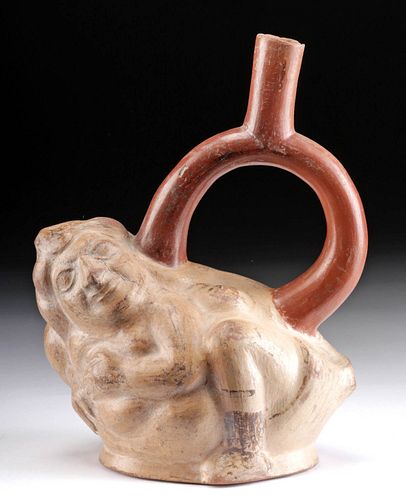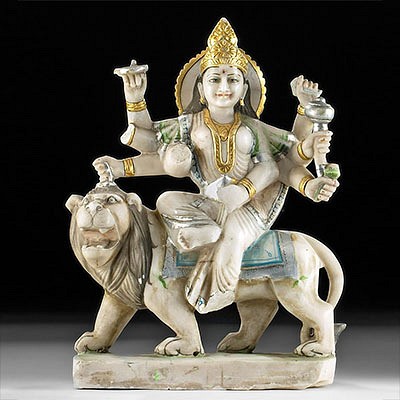Moche Bi-chrome Stirrup Vessel - Man & Tuber God
Lot 132b
About Seller
Artemis Gallery
686 S Taylor Ave, Ste 106
Louisville, CO 80027
United States
Selling antiquities, ancient and ethnographic art online since 1993, Artemis Gallery specializes in Classical Antiquities (Egyptian, Greek, Roman, Near Eastern), Asian, Pre-Columbian, African / Tribal / Oceanographic art. Our extensive inventory includes pottery, stone, metal, wood, glass and textil...Read more
Estimate:
$1,200 - $1,800
Absentee vs Live bid
Two ways to bid:
- Leave a max absentee bid and the platform will bid on your behalf up to your maximum bid during the live auction.
- Bid live during the auction and your bids will be submitted real-time to the auctioneer.
Bid Increments
| Price | Bid Increment |
|---|---|
| $0 | $25 |
| $300 | $50 |
| $1,000 | $100 |
| $2,000 | $250 |
| $5,000 | $500 |
| $10,000 | $1,000 |
| $20,000 | $2,500 |
| $50,000 | $5,000 |
| $100,000 | $10,000 |
| $200,000 | $20,000 |
About Auction
By Artemis Gallery
Jul 16, 2020
Set Reminder
2020-07-16 10:00:00
2020-07-16 10:00:00
America/New_York
Bidsquare
Bidsquare : Ancient / Ethnographic Art Through The Ages
https://www.bidsquare.com/auctions/artemis-gallery/ancient-ethnographic-art-through-the-ages-5334
Ancient art from Egypt, Greece, Italy and the Near East, as well as Asian, Fossils, Pre-Columbian, Native American, African / Tribal / Oceanic, Spanish Colonial, Russian Icons, Fine art, much more! Artemis Gallery info@artemisgallery.com
Ancient art from Egypt, Greece, Italy and the Near East, as well as Asian, Fossils, Pre-Columbian, Native American, African / Tribal / Oceanic, Spanish Colonial, Russian Icons, Fine art, much more! Artemis Gallery info@artemisgallery.com
- Lot Description
Pre-Columbian, North Coast Peru, Moche, Phase IV, ca. 500 to 700 CE. A hand-built pottery vessel of an intriguing form with a flat base, a cream-slipped body with protruding lateral ends, and a stirrup-shaped handle bearing red-orange pigment and a cylindrical spout projecting from the center. The bulbous body depicts a stylized man in a crouching position during the transformational process of becoming an effigy of the Moche Tuber God. The man stares out to his left with wide eyes and has hemispherical nodules growing across his chest and sides, and the wavy presentation of his back suggests he is nearly completely transformed. The Tuber God was an important deity among ancient Peruvian cultures due to the vital importance of potatoes and other similarly grown foodstuffs, and creating effigy vessels like this example was thought to ensure and protect bountiful harvests. Size: 6.75" L x 4.6" W x 8.6" H (17.1 cm x 11.7 cm x 21.8 cm)
For a stylistically similar example, please see Benson, Elizabeth P. "The Mochica: A Culture of Peru." Praeger Publishers, New York, 1972, p. 64, plate 3-22.
Provenance: private Washington, D.C., USA collection; ex-collection of Dr. and Mrs. Benjamin Kissin, New York, New York, USA, acquired between 1950 and 1975; ex-Arte Primitivo e-Variety auction, New York, New York, USA (auction 91, February 28, 2008, lot 149)
All items legal to buy/sell under U.S. Statute covering cultural patrimony Code 2600, CHAPTER 14, and are guaranteed to be as described or your money back.
A Certificate of Authenticity will accompany all winning bids.
We ship worldwide and handle all shipping in-house for your convenience.
#151816Minor abrasions to base, body, handle, and spout, with fading to areas of original pigment, small nicks to spout rim, and one stable fissure across face, otherwise intact and very good. Light earthen deposits and nice craquelure to original pigment throughout.Condition
- Shipping Info
-
All shipping is handled in-house for your convenience. Your invoice from Artemis Gallery will include shipping calculation instructions. If in doubt, please inquire BEFORE bidding for estimated shipping costs for individual items.
-
- Buyer's Premium



 EUR
EUR CAD
CAD AUD
AUD GBP
GBP MXN
MXN HKD
HKD CNY
CNY MYR
MYR SEK
SEK SGD
SGD CHF
CHF THB
THB















